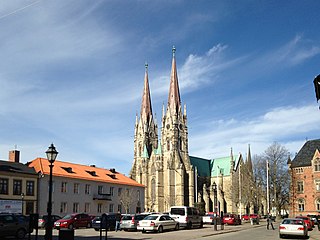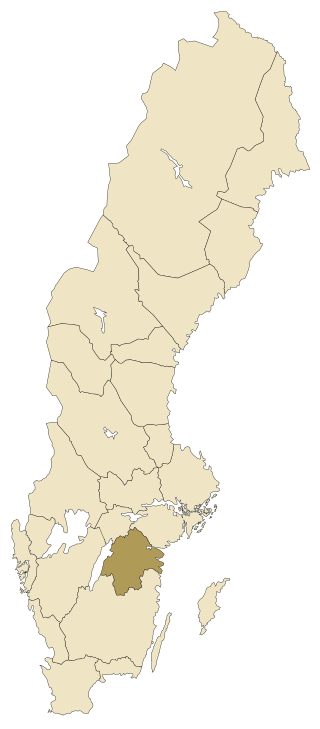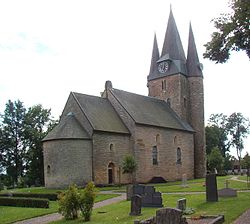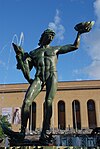
The Göta älv is a river that drains lake Vänern into the Kattegat, at the city of Gothenburg, on the western coast of Sweden. It was formed at the end of the last glaciation, as an outflow channel from the Baltic Ice Lake to the Atlantic Ocean and nowadays it has the largest drainage basin in Scandinavia.

Vänern is the largest lake in Sweden, the largest lake in the European Union and the third-largest lake in Europe after Ladoga and Onega in Russia. It is located in the provinces of Västergötland, Dalsland, and Värmland in the southwest of the country. With its surface located at 44 metres (144 ft) with a maximum depth of 106 metres (348 ft), the lowest point of the Vänern basin is at 62 metres (203 ft) below sea level. The average depth is at a more modest 28 metres (92 ft), which means that the average point of the lake floor remains above sea level.

Västra Götaland County is a county or län on the western coast of Sweden.

Halland is one of the traditional provinces of Sweden (landskap), on the western coast of Götaland, southern Sweden. It borders Västergötland, Småland, Scania and the sea of Kattegat. Until 1645 and the Second Treaty of Brömsebro, it was part of the Kingdom of Denmark. Its name means Land of Rocky Slabs referring to the coastal cliffs of especially the northern part of the region.

The provinces of Sweden are historical, geographical and cultural regions. Sweden has 25 provinces; they have no administrative function but remain historical legacies and a means of cultural identification pertaining to dialects and folklore.

The Geats, sometimes called Goths, were a large North Germanic tribe who inhabited Götaland in modern southern Sweden from antiquity until the Late Middle Ages. They are one of the progenitor groups of modern Swedes, along with Swedes and Gutes. The name of the Geats also lives on in the Swedish provinces of Västergötland and Östergötland, the western and eastern lands of the Geats, and in many other toponyms.

Bohuslän (Swedish pronunciation:[ˈbûːhʉːsˌlɛːn] is a Swedish province in Götaland, on the northernmost part of the country's west coast. It is bordered by Dalsland to the northeast, Västergötland to the southeast, the Skagerrak arm of the North Sea to the west, and the county of Østfold, in Norway, to the north. In English it literally means Bohus County, although it shared counties with the city of Gothenburg prior to the 1998 county merger and thus was not an administrative unit in its own right.

Dalsland is a Swedish traditional province, or landskap, situated in Götaland in southern Sweden. Lying to the west of Lake Vänern, it is bordered by Värmland to the north, Västergötland to the southeast, Bohuslän to the west, and Norway to the northwest.

Götaland is one of three lands of Sweden and comprises ten provinces. Geographically it is located in the south of Sweden, bounded to the north by Svealand, with the deep woods of Tiveden, Tylöskog and Kolmården marking the border.

Älvsborg County was a county of Sweden until 1997, when it was merged with the counties of Gothenburg & Bohus and Skaraborg to form Västra Götaland County.
The Götaland theory is a view which challenges established history and archaeology, and claims that the foundation of Sweden occurred not in Eastern Sweden, but in the province of Westrogothia (Västergötland). The adherents of this idea use wide-ranging methods, from controversial ones, such as dowsing and asking mediums to contact the dead, to more conventional methods such as etymology, but also claim that the established academic material consists of lies and forgeries. Although well known in Sweden and fervently preached by its adherents, it has never been accepted by scholars.

Vänersborg is a locality and the seat of Vänersborg Municipality, Västra Götaland County, Sweden with 23,882 inhabitants Until 1997 it was the capital of Älvsborg County, which was dissolved in 1998. Since 1999 Vänersborg has been the seat of the regional parliament of Västra Götaland County. The city is located on the southern shores of lake Vänern, close to where the river Göta älv leaves the lake.

Skara is a locality and the seat of Skara Municipality, Västra Götaland County, Sweden with 18,580 inhabitants in 2013. Despite its small size, it is one of the oldest cities in Sweden, and has a long educational and ecclesiastical history. One of Sweden's oldest high schools, Katedralskolan, is situated in Skara. The former county of Skaraborg was named after a fortress near the town.

Karlsborg is a locality and the seat of Karlsborg Municipality, Västra Götaland County, Sweden. It had 3,551 inhabitants in 2010. This garrison town lies at the shore of lake Vättern in Västergötland.

Ätran is a Swedish river. The river is about 240 kilometres (150 mi) long, and has its source in Gullered, Västergötland, at a height of 332 metres (1,089 ft) above sea level. The river has its mouth in Falkenberg, Halland, where the river enters Kattegat.
Eskil Magnusson was a nobleman and lawspeaker (Lagman) of Västergötland. He is the first attested legal official in what is now Sweden about whom extensive information is available.

Vättern is the second largest lake by surface area in Sweden, after Vänern, and the sixth largest lake in Europe. It is a long, finger-shaped body of fresh water in south central Sweden, to the southeast of Vänern, pointing at the tip of Scandinavia. Being a deep lake at 128 metres (420 ft) below sea level at its deepest point, Vättern is about 1/3 the surface area of Vänern but in spite of this contains roughly 1/2 of its water.

Östergötland is one of the traditional provinces of Sweden in the south of Sweden. It borders Småland, Västergötland, Närke, Södermanland and the Baltic Sea. In older English literature, the Latinized version Ostrogothia is also used. The corresponding administrative county, Östergötland County, covers the entire province and parts of neighbouring provinces.

The Church ruins of Agnestad are church ruins in Falköping parish in Västra Götaland, Sweden.
Sweden held a general election on the 16 September 1973. Results are published by the Statistical Central Bureau.























